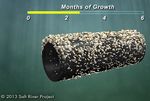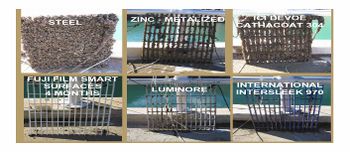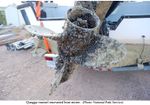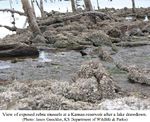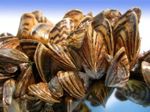Difference between revisions of "Quagga"
Cellsworth (Talk | contribs) |
Cellsworth (Talk | contribs) |
||
| Line 17: | Line 17: | ||
</table> | </table> | ||
| − | [[Image:Quagga Pic (1).JPG|thumb|left| | + | [[Image:Quagga Pic (1).JPG|thumb|left|450px]] |
<!-- | <!-- | ||
| Line 24: | Line 24: | ||
|style="width:60%; font-size:120%;"| | |style="width:60%; font-size:120%;"| | ||
| − | |||
| − | |||
| − | |||
|}<!-- | |}<!-- | ||
| Line 45: | Line 42: | ||
|style="color:#000;"| | |style="color:#000;"| | ||
| + | Quagga mussels continue to be a major problem in the Colorado River. Since being discovered in Lake Mead in the Lower Colorado River in early 2007, the quagga mussels have spread rapidly in the watershed. Young mussels float in the water column and get carried by the water currents downstream, while adults attach themselves to the bottoms of boats and can be transported miles away. Quagga mussels, natives of Europe and Asia discovered in the Great Lakes region in the late 1980s, can grow to about 1.5 inches and are clogging water lines that are used to cool the 17 massive hydropower turbines at Hoover Dam. They have caused similar problems at the downstream Davis Dam in Lake Mohave and Parker Dam in Lake Havasu, both of which provide electricity for thousands of people in Arizona and California. Reclamation, which operates the Hoover, Davis and Parker dams, has employed divers with high-pressure water hoses to blow mussels out of pipelines and filter gates. But those treatments are expensive, and the results are only temporary. | ||
| + | "Mussels have the potential to disrupt water delivery and hydropower generation functions and to create long-term economic impacts...," | ||
| + | |||
| + | "The risk of Dreissena establishing within the CRE is low, except for the Lees Ferry tailwater reach where the risk appears high. Dreissena are unlikely to establish at high densities within the CRE or its tributaries because of high suspended sediment, high ratios of suspended inorganic:organic material, and high water velocities, all of which interfere with the ability of Dreissena to effectively filter feed. The rapids of Grand Canyon may represent a large source of mortality to larval Dreissena, which would limit their ability to disperse and colonize downstream reaches of the CRE. In contrast, conditions within the Lees Ferry tailwater generally appear suitable for Dreissena establishment, with the exception of high average water velocity." [https://pubs.er.usgs.gov/publication/ofr20071085] | ||
|} | |} | ||
| Line 70: | Line 71: | ||
|style="color:#000;"| | |style="color:#000;"| | ||
| + | *[https://pubs.er.usgs.gov/publication/ofr20071085 Kennedy, 2007, A Dreissena Risk Assessment for the Colorado River Ecosystem, USGS Open-File Report ] | ||
| + | *[http://www.usbr.gov/uc/rm/amp/twg/mtgs/15jan20/Attach_17.pdf Quagga Mussel Risk Assessment ppt] | ||
| + | *[http://www.usbr.gov/uc/rm/amp/amwg/mtgs/14feb19/Attach_12.pdf Quagga Mussels-Impacts and Solutions for Hydropower Facilities ] | ||
| + | *[https://www.usbr.gov/uc/rm/amp/twg/mtgs/13jan24/Attach_11.pdf A Dreissena Risk Assessment for the Colorado River Ecosystem (presented to AMWG in May 2007 by Ted Kennedy)] | ||
|- | |- | ||
| Line 75: | Line 80: | ||
|- | |- | ||
|style="color:#000;"| | |style="color:#000;"| | ||
| − | |||
|} | |} | ||
| − | |||
<Span></Span> | <Span></Span> | ||
| − | |||
| − | |||
| − | |||
| − | |||
| − | |||
| − | |||
| − | |||
| − | |||
| − | |||
| − | |||
| − | |||
| − | |||
| − | |||
| − | |||
| − | |||
| − | |||
| − | |||
| − | |||
== Quagga Facts/ Trivia == | == Quagga Facts/ Trivia == | ||
| Line 104: | Line 89: | ||
== '''What are the Currently Effective Control Methods Used for Mussels?''' == | == '''What are the Currently Effective Control Methods Used for Mussels?''' == | ||
| − | |||
''Methods of Control'':[http://www.irs.gov/pub/irs-pdf/p950.pdf] | ''Methods of Control'':[http://www.irs.gov/pub/irs-pdf/p950.pdf] | ||
<span style="font-size:85%>Oxygen Deprivation | Temperature Treatments | Exposure and Dessication| Ultraviolet Radiation | Manual Scraping | High-pressure Jetting | Mechanical Filtration | Passive and Barrier Filtration | Removable Substrates | Chemicals ('''Chlorine''') or Molluscicides | Ozone | '''Antifouling Coatings''' | Electric Currents| Sonic Vibration | Natural Predators or Biological Controls| Bacteria ('''Pseudomonas Fluorescens''')</span> | <span style="font-size:85%>Oxygen Deprivation | Temperature Treatments | Exposure and Dessication| Ultraviolet Radiation | Manual Scraping | High-pressure Jetting | Mechanical Filtration | Passive and Barrier Filtration | Removable Substrates | Chemicals ('''Chlorine''') or Molluscicides | Ozone | '''Antifouling Coatings''' | Electric Currents| Sonic Vibration | Natural Predators or Biological Controls| Bacteria ('''Pseudomonas Fluorescens''')</span> | ||
| − | |||
=='''Quagga Mussel Information''' == | =='''Quagga Mussel Information''' == | ||
| Line 114: | Line 97: | ||
*Quaggas tolerate colder temperatures, and are more abundant at greater depths, reproduce at lower temperatures, and are more likely to grow in single layers and produce more patchy distributions. | *Quaggas tolerate colder temperatures, and are more abundant at greater depths, reproduce at lower temperatures, and are more likely to grow in single layers and produce more patchy distributions. | ||
*Unlike Zebras, Quaggas don't necessarily need hard substates to attach and grow. They can grow on the soft, silty bottom sediments. | *Unlike Zebras, Quaggas don't necessarily need hard substates to attach and grow. They can grow on the soft, silty bottom sediments. | ||
| − | |||
=='''Quagga Mussel Archive'''== | =='''Quagga Mussel Archive'''== | ||
| Line 120: | Line 102: | ||
*[http://www.jsonline.com/story/index.aspx?id=767291 JS-Online_Quagga Video link_Affects to the shore line of Great Lakes] | *[http://www.jsonline.com/story/index.aspx?id=767291 JS-Online_Quagga Video link_Affects to the shore line of Great Lakes] | ||
*[http://www.reviewjournal.com/media/slideshow/quagga_mussels/ 080509_Quagga Video Feed at Fish Hatchery] | *[http://www.reviewjournal.com/media/slideshow/quagga_mussels/ 080509_Quagga Video Feed at Fish Hatchery] | ||
| − | |||
| − | |||
== Rules and Laws == | == Rules and Laws == | ||
*Utah law prohibits the transport of quagga mussels — dead or alive — through the state. Violators are subject to thousands of dollars in fines and up to one year in jail for a crime that is classified as a Class A misdemeanor. | *Utah law prohibits the transport of quagga mussels — dead or alive — through the state. Violators are subject to thousands of dollars in fines and up to one year in jail for a crime that is classified as a Class A misdemeanor. | ||
| − | |||
[http://www.usbr.gov/lc/region/programs/quagga.html The Bureau of Reclamation- Quagga web-page] | [http://www.usbr.gov/lc/region/programs/quagga.html The Bureau of Reclamation- Quagga web-page] | ||
| Line 136: | Line 115: | ||
---- | ---- | ||
| + | |||
| + | [[File:2013 SRP Quagga in Pips animation- PIC.jpg|150px]]'''[[Media:Quaggas Pipe 2013.mp4| Quagga Pipe 2013-Video Clip- Courtesy of Salt River Project]]''' | ||
| + | [[Image:Quagga Surface Tests.jpg|thumb|right|150px]] | ||
| + | [[File:Quagga Surface Tests.jpg|thumb|left|350px]] | ||
| + | [[File:141016 USBR Quagga Research Report-PIC.jpg|90px]] | ||
[[File:Pipe Encrusted with Zebra Mussels.jpg|150px]] [[File:Quagga Mussel encrusted boat motor.jpg|150px]] [[File:View of Exposed Zebra Mussels.jpg|150px]] [[File:Zebra and Quagga Mussels.jpg|150px]] [[File:Zebra mussels (Dreissena polymorpha).jpg|150px]] | [[File:Pipe Encrusted with Zebra Mussels.jpg|150px]] [[File:Quagga Mussel encrusted boat motor.jpg|150px]] [[File:View of Exposed Zebra Mussels.jpg|150px]] [[File:Zebra and Quagga Mussels.jpg|150px]] [[File:Zebra mussels (Dreissena polymorpha).jpg|150px]] | ||
Revision as of 15:08, 13 March 2018
|
|
|
| -- |
-- |
-- |
|---|
|
Quagga Facts/ TriviaWhat are the Currently Effective Control Methods Used for Mussels?Methods of Control:[2] Oxygen Deprivation | Temperature Treatments | Exposure and Dessication| Ultraviolet Radiation | Manual Scraping | High-pressure Jetting | Mechanical Filtration | Passive and Barrier Filtration | Removable Substrates | Chemicals (Chlorine) or Molluscicides | Ozone | Antifouling Coatings | Electric Currents| Sonic Vibration | Natural Predators or Biological Controls| Bacteria (Pseudomonas Fluorescens) Quagga Mussel InformationZebra VS Quaggas:
Quagga Mussel Archive
Rules and Laws
The Bureau of Reclamation- Quagga web-page
LINK to Video Clip--- USBR Mussels Page |
